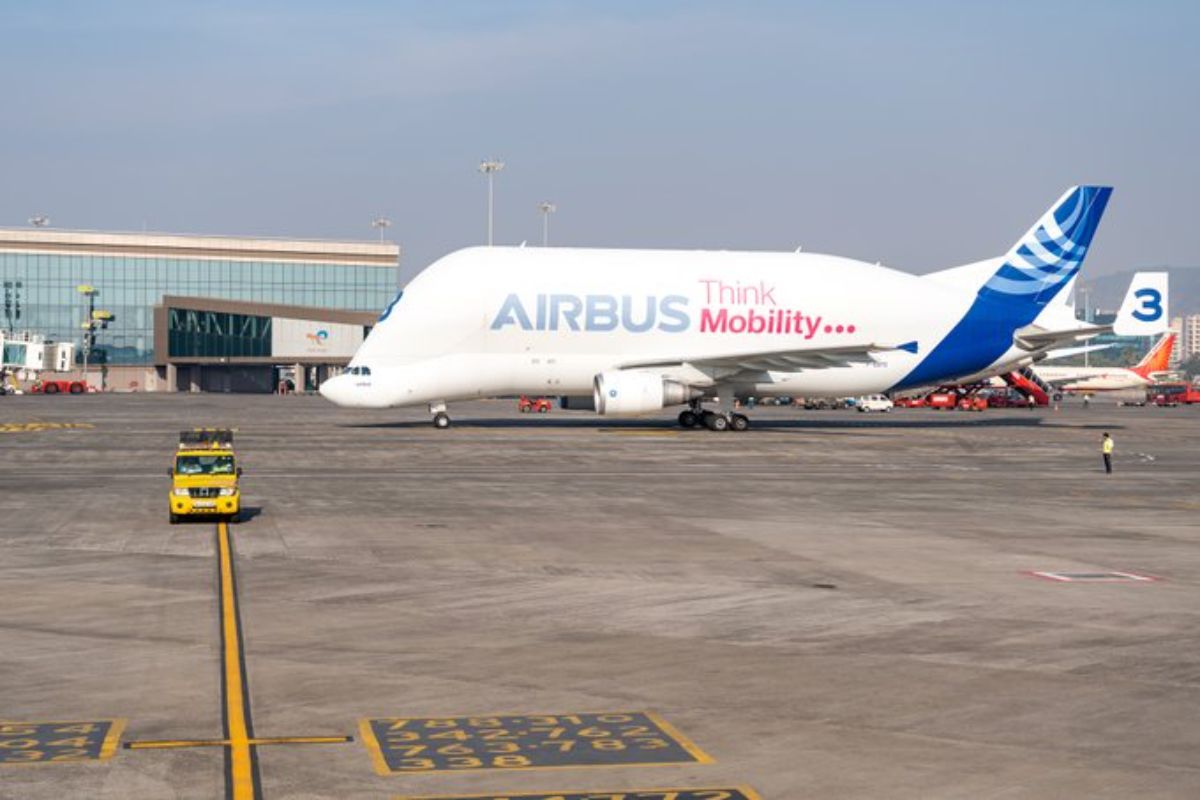

On November 22, the whale-shaped Airbus Beluga super transporter aircraft made a stunning entrance at Mumbai’s Chhatrapati Shivaji Maharaj International Airport (CSMIA), leaving both airport personnel and travellers in amazement.
Internet users are in awe after seeing pictures of one of the largest aircraft that have appeared online. One of the features of this super transporter is that it looks like a whale. Due to its size, this aeroplane has not only been the focus of attention among travellers, but it is also distinctive in its own right.
The images of the Airbus Beluga landing at the CSMIA were shared by the airport’s official Twitter handle. “Look who made a pit stop at @CSMIA_Official! The Airbus Beluga Super Transporter made its first appearance at #MumbaiAirport and left us all awestruck. Tell us what you think of its unique design.” the tweet read.

Additionally, on November 20, Kolkata’s Netaji Subhash Chandra Bose International Airport welcomed the whale-shaped super transporter Airbus Beluga. The news and images of one of the largest planes in the world were posted on Twitter by Kolkata Airport for the benefit of internet users.
The A300-600ST Beluga: A flying giant
The Beluga whale is the source of the name Airbus “Beluga.” Various space programmes and other large, heavy goods are transported using the Airbus Beluga. There has been increased demand for large aeroplanes.
The enormous A300-600ST Beluga, also known as the Beluga ST, is made by the European multinational aerospace company Airbus and measures 56.15 metres in length, 17.24 metres in height, and 44.84 metres in width. It has the largest cargo hold of any modern civil or military aircraft, with a capacity of 47,000 kg.
Read More: Air India has Leased Six New Airbus A320neo Aircraft, all You Should Know
To function, a larger plane requires a larger engine. The GE CF6-80C2A8 engines that power Airbus Beluga has a cruise speed of 0.7 Mach. 35,000 feet is the maximum operating altitude. The projected price of the aircraft is $284 million.
Beluga: Super Transporter
The first flight of the A330-200, the original Beluga, took place in 1994. Officially, it was referred to as the Super Transporter. The fact that it is white and has a front that resembles sociable whales with prominent foreheads quickly earned it the name “beluga,” though. The aircraft that touched down in Mumbai was an A300-600ST, which went into service in January 1996.
The A300-cargo 600ST’s hold measures 7.08 metres in height, 7.04 metres in width, and has a useful length of 37.70 metres. The main deck’s location makes the movement of goods by roll-on and roll-off simple. According to the website Aerospace Technology, it has a sizable single-piece primary cargo door that opens forward and upward to provide easy access to the cargo area.
The largest Beluga
Two Chinook transport helicopters can be transported within the aircraft, folded blades and all, without needing to be taken apart and put back together.
A transportable heating module with controls in the cockpit provides temperature-controlled environments for delicate payloads like satellites and even artwork. In order to move space station components, helicopters, items of art, and humanitarian goods, the Super Transporter was essential.
It sent a brand-new satellite to Florida’s Kennedy Space Center in 2022. The freighter is perfect for transporting cutting-edge space technology thanks to its spacious cargo entrance and capacity. It delivered the Eutelsat W3A satellite in 2004 to Kazakhstan’s Baikonur Cosmodrome, where it was launched. Large and fragile space systems like the 3,500 kg, 9 m long aluminium fuel tank for the NASA X-33 VentureStar spacecraft have been transported by it.
Read More: Airbus Beluga Can be Leased for Cargo Services by Private Companies
Five different Beluga aircraft models are currently in use; the last one started flying in 2000. There are currently no plans in place for a sixth Beluga to be produced. A fleet of BelugaXL versions from the latest generation is gradually replacing the BelugaST models.
The XL is more than twice as enormous as the blue whale, the largest living mammal on Earth, which measures between 24 and 30 meters in length. Two $40 million apiece Rolls-Royce Trent 700 Turbofan engines propel the BelugaXL through the air. Over $1 billion was spent on the entire effort to develop these devices.
- Coinsmart. Europe’s Best Bitcoin and Crypto Exchange.Click Here
- Platoblockchain. Web3 Metaverse Intelligence. Knowledge Amplified. Access Here.
- Source: https://aviationscoop.com/the-whale-shaped-airbus-beluga-makes-its-debut-appearance/70866/



